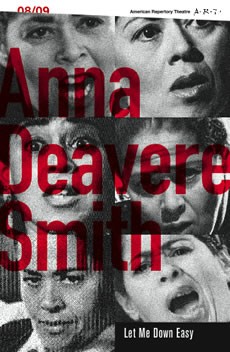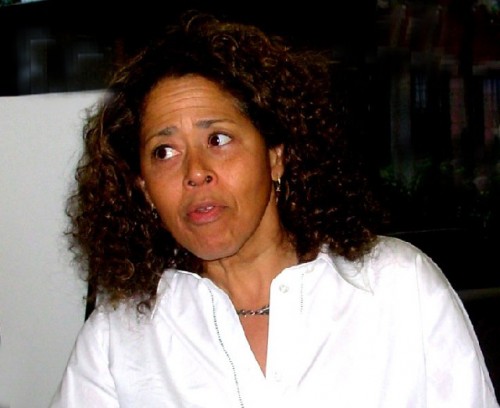Let Me Down Easy At American Rep Theatre
Anna Deavere Smith's Amazing Grace
By: Mark Favermann - Sep 28, 2008
LET ME DOWN EASY
The Loeb Drama Center
64 Brattle Street, Cambridge, MA 02138
Conceived, written, and performed by Anna Deavere Smith
Directed by Eric Ting
Original musical elements by Joshua Redman
Set Design by David Rockwell
Costume Design by Ann Howard-Ward
Lighting Design by Michael Chybowski
Sound Design by David Remedios
Photography by Diane Walker
Projection Design by Jan Hartley
September 12 thru October 11, 2008
Running time is two hours, 15 minutes including one intermission.
http://www.amrep.org
Anna Deavere Smith is the Tony Award winning and Pulitzer Prize nominated artist who creates collages. These collages are at at once visual, metaphorical and while emotion-laden often quite cerebral. Her source material is the poignancy of contemporary life. Her glue is comprised of universal pain, strategic experience and human spirit. There are performers and there are great performers. Anna Deavere Smith at her best is truly a great performer. Smith's artistic range and nuanced emotional intellect are rare traits. Her next performance pieces are always highly anticipated.
Smith is widely recognized for her more commercial roles in the television series The West Wing and in the film The American President. Her one-woman performance pieces are recognized as great theatrical and artistic experiences. She has also won Obie off-Broadway awards and the MacArthur Award, the genius prize.
Currently, at the American Repertory Theatre, in Let Me Down Easy, Smith is performing another of her unique one-woman shows that focuses upon various aspects of the notions of "grace." She places moments of people's lives overlapping and side-by-side. Words, gestures and images form a textural and highly visual work. Constructed from interviews and archival pieces, Smith wrestles with the conflict of grace and kindness in a world of almost unfathomable distress and suffering. There is no storyline but a clear narrative theme between, through and overlapping Smith's vignettes.
She applies together the words and cadences of her childhood church's rural raised preacher with the sophisticated elocutions of a distinguished Harvard theologian alongside the less articulate but still quite spiritual expressions of a Kentucky Derby jockey to the dismay and incredible optimism of a Rwandan Tutsi genocide survivor to a professor lauding the beauty of her transient flower garden and the observational sensitivities of a cutting-edge international photojournalist.
She performs the various characters by attempting to submerge herself in their roles and personal traits. Though some work better than others, the whole of her performance transcends the various parts. She not only mirrors a bit of each personality, but also captures a descriptive experiential moment always dramatically and sometimes even poetically. Each of her parts is about individuals who use language in quite extraordinary ways.
On a purely theatrical basis, this performance piece starts quietly and slowly. Her portrayals of her mother's Arkansas bred minister and Harvard's wonderful dapper oratory theological genius Reverend Peter Gomes are lacking in some energy essence. These characters seem to require a bit more precise imitation. Perhaps Smith was trying not to mirror them but just to echo them philosophically? Though, as the performance went on, she built dramatic and theatrical momentum with each of the other character depictions.
Life and death in the balance are strategic aspects to Smith's collage. Vignette's about the seemingly gracelessness and deterioration of the American healthcare system with a middle age cancer patient at the Yale-New Haven Medical Center, the putting down of the second place filly at the recent Kentucky Derby, the incredible callousness of the treatment of the victims of Hurricane Katrina in New Orleans, the nonsensical denial of the pervasive AIDS epidemic in South Africa by its recently deposed Prime Minister, notion of perennial flowers in a garden discussed by a professor, and the eloquent yet shocking story of the Rwandan genocide survivor express grace in profound and profane ways.
Her portrayal of the former outspoken and appealing Texas Governor Ann Richards optimistically dying from esophageal cancer is particularly symbolic on layered levels since Richards was defeated by George W. Bush for reelection. What if and why?
The Rwandan woman matter-of-factly stated, "If you stone someone to death, it takes time. But you can't think if you're cutting someone's head off." This is horror beyond any sense of civilized redemption. However, expressed like this, there is a grace in her words. Smith finds this tone, this grace note.
Smith's concept of grace is not easy. Her audience must deal with grace in many divergent and yet affecting forms. Grace can be problematic. Grace can be ambivalent. Grace can be rather ordinary. And grace can be surprisingly triumphant while much in the world is disgraceful. Anna Deavere Smith deals with both history and memory often contradicted by standards of human behavior. Time may not heal perfectly, but it focuses more clearly.
In this nuanced performance, Smith seems to puzzle over and weigh the words of the hymn, "Amazing grace, how sweet the sound, that saved a wretch like me." This is a hymn or spiritual of the traditional Black church, this is also a hymn at funerals played usually on bagpipes over and over after 9/11 and it is a prayer for human redemption. Grace suggests hope. Grace suggests forgiveness.
The audience is always a major character in Anna Deavere Smith's performance pieces. The audience members bring their own notions of personal history, ethical behavior, and mortality as well as senses of individual sorrow and redemption infused with life and loss. Smith's works are about specific moments and perceptions of personal and communal engagement. This is an engagement of emotions, of personal and institutional morality and perceived failures along with often small but sometime far-reaching personal triumphs. Smith allows us to see.
As usual, the technical aspects of the American Repertory Theatre's production are exquisite. The set is amazing. It is simple, an abstract movable backdrop that is a beautiful closed screen that opens to create a view of landscapes of mind and physical environment. Designed by architect/designer David Rockwell, this beautiful structure would hang proudly in any contemporary art gallery or major museum.
Evocative, poignant and just beautiful, the large format photographs were terrific. Put together by Diana Walker and projected by Jan Hartley, these images both quickly paced and extended were masterly done giving a depth and visual cohesion to Smith's words.
Anna Deavere Smith's work leaves a visceral resonance. Sometimes this is a thoughtful tickle at the back of our minds or a stomach churning lingering harsh reaction to a bitter or tragic moment or period of time. At other times, it is a lingering thought, a shocking perception or a focused insight. Smith has the ability to transcend normal theatrical experience. She allows the audience to be part of her own observations and interpretations. We are moved by abstractions of grace along with examples of grace in action. Anna Deavere Smith's performance is a piece of great contemporary American stagecraft and high art.
"Amazing Grace, how sweet the sound
That sav'd a wretch like me!
I once was lost, but now am found,
Was blind, but now I see."
By John Newton, a former slave ship captain, 1779





